Methods for combating diseases and pests of spruce trees
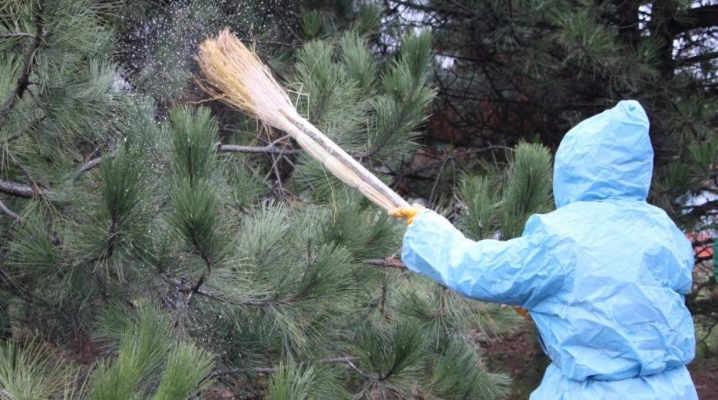
Conifers are very often used in landscape design as they retain their beautiful decorative appearance all year round. However, various diseases and pests, affecting spruce, harm their decorative qualities.

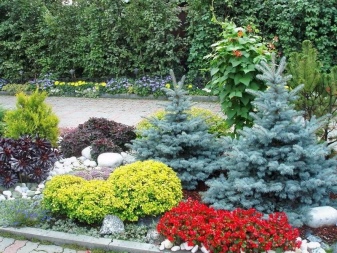
Symptoms and Causes
The causes of various diseases in firs are various infections. Basically, spruce is affected by fungal and other types of bacterial infections, as well as pathogenic microorganisms that are present in the soil.
Fungal infections occur most often with a very dense planting of fir trees, with insufficient lighting and excess moisture.
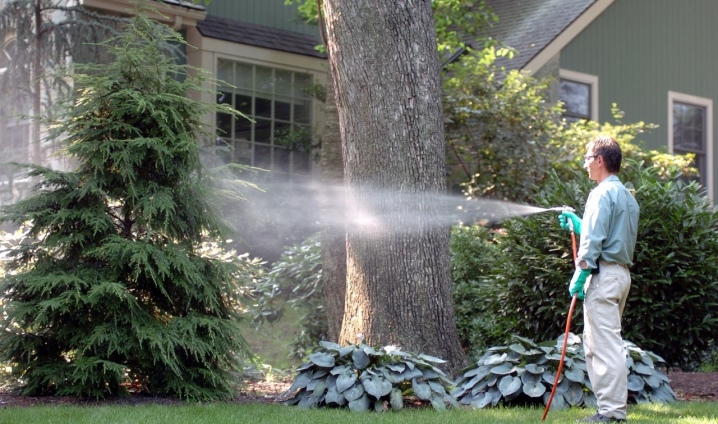
And also non-infectious diseases can occur in spruce, the main causes of which are factors such as:
- violation of planting rules (strong deepening of the seedling into the soil);
- an unfavorable landing site for spruce on the site;
- improper care;
- unsuitable climatic conditions.
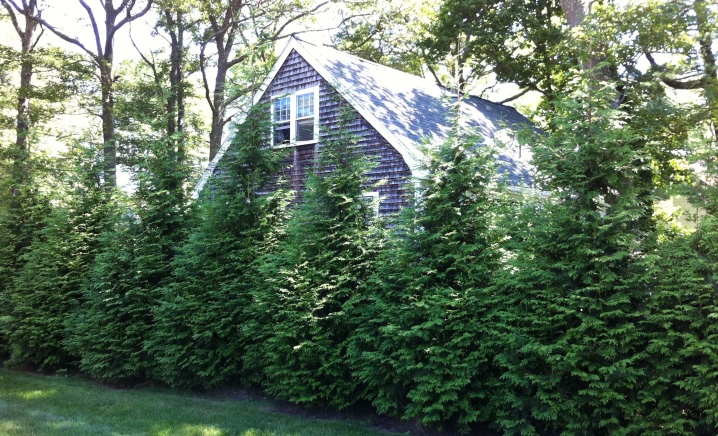
All these reasons lead to the fact that there are consequences that negatively affect the health of the tree, namely:
- stagnation of water in the ground;
- high acid composition of the soil;
- poor aeration of trees due to excessive density of spruce planting;
- lack of lighting;
- excess or lack of fertilizers;
- waterlogging of soil and air;
- drought in summer and very low temperatures in winter.
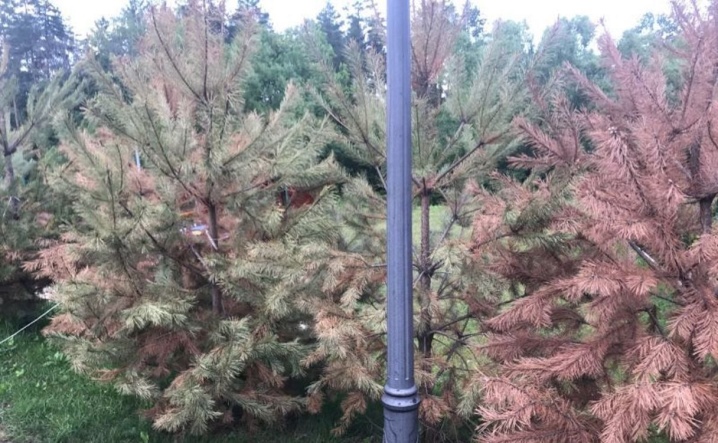
Healthy spruce has a beautiful lush crown of rich color. Any change in the appearance of the tree indicates the occurrence of any disease or pest infestation.
Each specific disease has its own specific symptoms. However, it is possible to determine that the spruce is sick by such general symptoms as:
- the needles dry up, crumble, turn yellow, turn red or brown, and then fall out;
- yellow dots appear on the needles;
- the needles fall off, and the bare branches become covered with dark spots;
- cracks appear on the trunk, where resin and orange bubbles form;
- the cones are covered with dark spots, which contain spores of rust fungi, as a result, the cones open wide;
- spruce shoots begin to grow crooked.
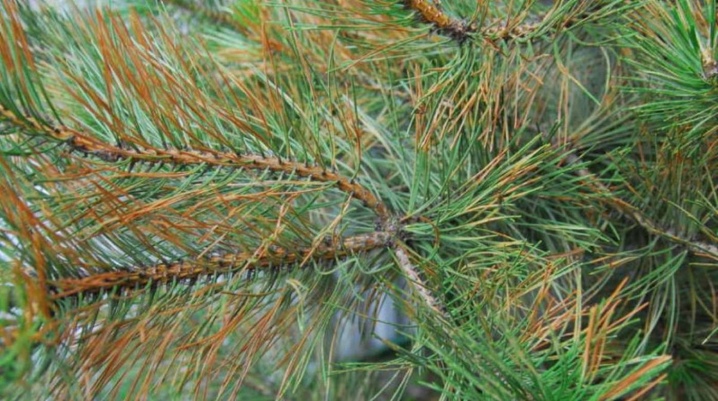
Although many types of spruce do not tolerate cold weather, common spruce suffers the least from frost.
Low winter temperatures, as well as frosts in the spring, can cause such harm to the plant: the needles dry out, the spruce loses its needles. With a disease of the roots and trunk of the spruce, the top dries, and fungal growths may appear on the trunk. The appearance of a white bloom on the needles indicates that the tree is damaged by pests.
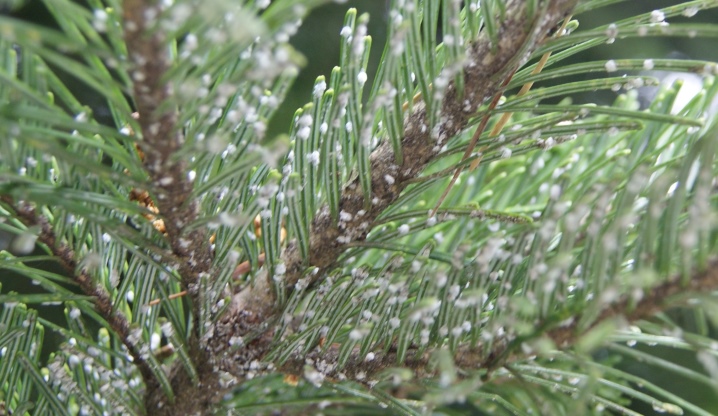
Description of parasites
Harmful insects are also very dangerous for the spruce and can do great harm to it. All parasites that infect it are divided into the following types:
- sucking;
- pine needles;
- stem pests.
They all have their own characteristics, each in its own way harms the tree.
Sucking
Spider mites and aphids are sucking pests. They are characterized by settlement on spruce trees in separate colonies, which makes it easier for them to survive and simplifies reproduction. First of all, they infect the needles, sucking juice from it, and then spread throughout the tree. Let's consider each parasite in more detail.
- Spider mite. A sign of defeat is the appearance of a thin web, which first covers the needles in places, picking out young new branches. On it you can see crawling mites that feed on juice, sucking it out of the needles and different parts of the spruce.As a result, yellow spots form on the needles, the needles become brown, die off and crumble. The spider mite is an extremely small insect, reaching sizes from 0.3 to 0.5 mm. The mite has an oval body covered with small spines in the form of needles. On his thin limbs (there are only 8 of them) there are small claws, with the help of which he clings to the needles. The insect has special glands that secrete a cobweb, with which it entangles coniferous needles, branches, and a trunk. The cobweb carried by the wind also serves to settle them. They spend winter settling in the bases of coniferous bunches or in the bark under the scales.
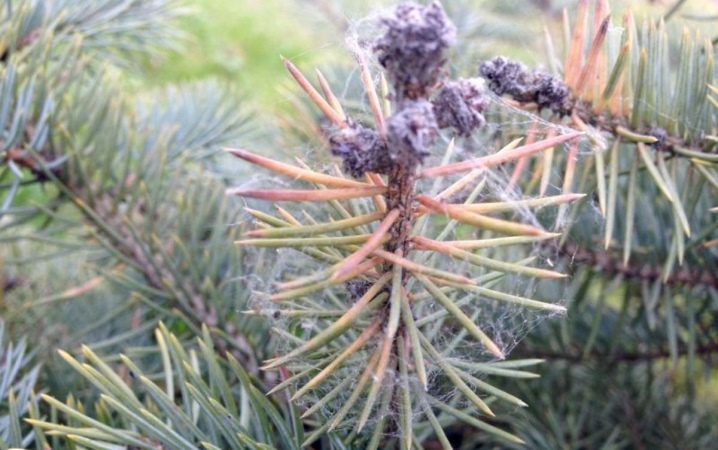
- Aphid. It is also very dangerous for the plant. Sucking the sap from the spruce, the aphid not only weakens the tree, but also infects it with its toxins, which are produced during its life. And this leads to the occurrence of fungal diseases. A feature of aphids is their ability to form thousands of colonies. It is so small that it is almost impossible to see it with the naked eye. Its size does not exceed 2 mm. The insect has a light green elliptical body with a soft cover. It is covered with pimples, growths and fluff of different lengths. Aphids have special proboscis, with which they bite through needles, the surface of branches and shoots. Reproduction is carried out by eggs, which the females lay in the fall, they winter well. A sign of the appearance of aphids is the appearance of yellow spots on old needles, which eventually fall off. In addition, a viscous bloom appears on the needles, attracting red ants, which further contribute to the spread of aphids.
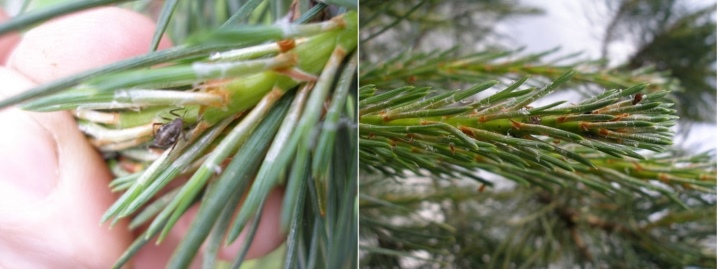
Pine needles
Among the needle-gnawing parasites, it is worth highlighting those which are the most dangerous.
- Spruce sawfly. An adult insect is very similar in appearance to a fly. But the greatest harm to the spruce is caused by its larvae, resembling green caterpillars. They settle in groups and feed only on old needles, eating all the needles and leaving only small fragments. At the same time, the crown of spruces takes on an openwork appearance. Sexually mature females of the sawfly lay their eggs in the epidermis of spruce needles. Their number in one egg-laying reaches 1.5–2 thousand pieces. In total, during the summer period, the female lays eggs twice and 2 generations of insects are hatched.
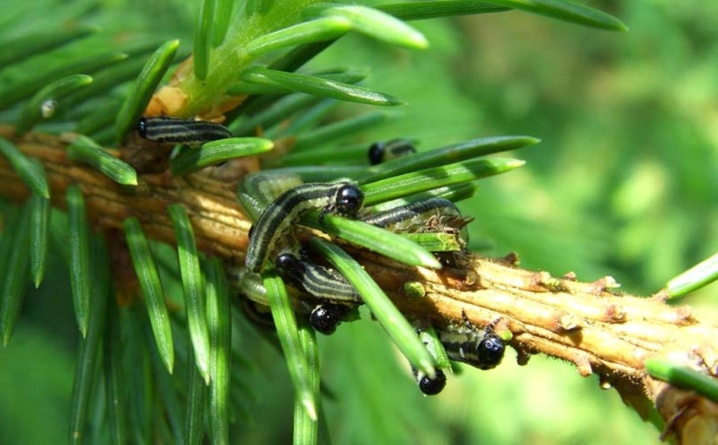
- Spruce moth Is a small butterfly painted in gray tones with white strokes. She makes clutches of her eggs near the buds and on pins and needles. Later, the developed caterpillars mine spruce needles, and then make a move in the outer layer of the bark of young branches and cover it with white cobwebs. Affected branches slow down their growth, acquire ugly shapes, and dry out with severe damage. The main symptoms of moth infestation are bare branches and spruce needles tangled in cobwebs.

Stem
Trunk pests include the typographer bark beetle, a large spruce bark beetle, which destroy the bark and wood of the spruce, since the larvae laid by them grow and develop under the bark and gradually penetrate deep into the trunk. While in the bark, insects secrete strong-smelling substances (pheromones) that attract other beetles.
A tree affected by bark beetles most often dies.
Let's consider the most popular pests in more detail.
- Bark beetle typographer. It is a small insect with a shiny brown body and a length of 4.2 to 5.5 mm. Most often, it affects weakened spruce. The needles become dull, then they turn yellow and eventually fall off. The beetle makes many small holes on the bark. The circumference of the trunk is covered with abundant brownish drill meal. In the wood under the bark, the beetle makes numerous passages and chambers where females lay their eggs. Later, the larvae, feeding, gnaw wood, moving deeper into the trunk. Thus, they weaken the tree, which as a result dies. In case of massive defeat, they are capable of destroying large spruce tracts.

- Large spruce bark beetle. This beetle is the largest of the bark beetles.It can be up to 9mm in length. It has a black, smooth and shiny surface, limbs and antennae of a red-rusty hue. The body and legs are covered with long, bristling yellow bristles. This is also a very dangerous and active pest that mainly affects old spruce trees, but it will not refuse young growths either. Its larvae harm the tree like the larvae of a typographer beetle. Signs of damage are reddening of the needles and the presence of resin funnels in the entrance holes in the trunk.
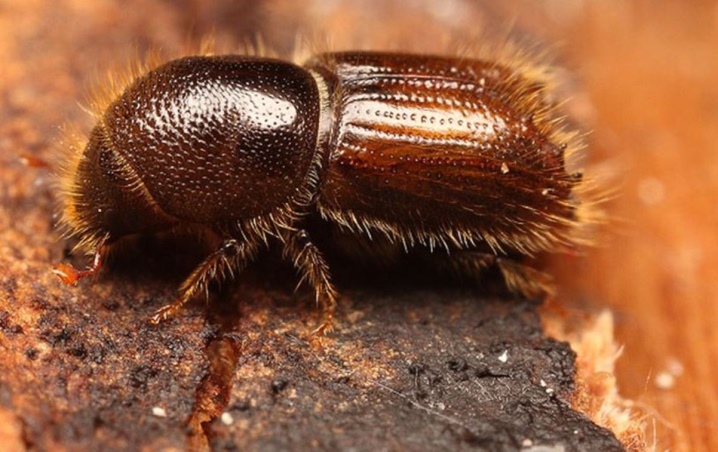
Drill meal may also appear on the wellbore. The vital activity of this pest can lead to the death of the tree. Buds are also a favorite food for parasites. Usually they are attacked by caterpillars such as leafworm, moth, moth and others. Sick bumps are highlighted in a changed color, they become crooked, dust appears in them. Caterpillars feed on seeds. Outside the cones, heaps of brown insect excrement and occasionally resin drips form.
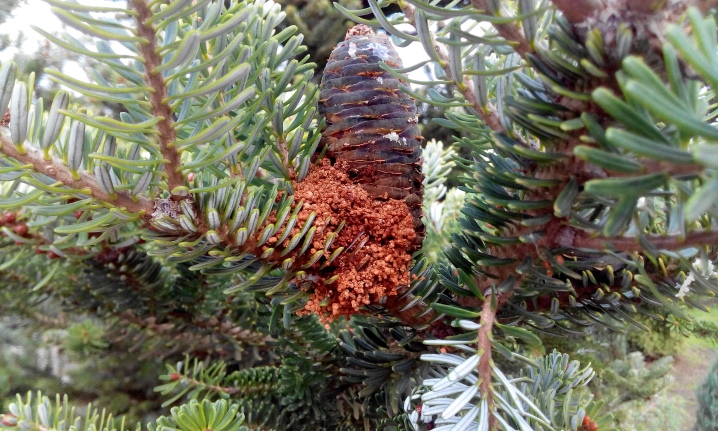
By destroying seeds, these pests harm the reproduction of spruces.
Common diseases
Ate, like other trees, can suffer from various diseases. The most common diseases should be considered.
Schütte
This disease occurs as a result of infection with marsupial fungi (ascomycetes) and is a fungal infection. It can manifest itself and proceed in different forms.
- The present. Early signs of the disease appear in late spring and are expressed in a change in the state of the needles - it turns brown and dies. Yellow spots appear in the fall. And only the next spring, on the underside of the needles, small shiny brown bulges form, containing mushroom spores, which later turn black. They can spread to small spruce twigs. The growth of firs slows down, the needles dry, die off and crumble. Mostly young or weakened trees are ill.
- Snowy. This fungal disease is widespread in the north of Russia. But sometimes it is also found in the central part. The disease occurs under the snow cover at zero air temperature and manifests itself in the reddening of the needles. In summer, the disease develops intensively, the needles become gray, dry out and crumble. The diseased branches are covered with large black dots that contain fungal spores.
- Brown. A characteristic feature of this type of disease is that the brown and dead needles do not crumble. Therefore, it promotes the subsequent spread of infection throughout the tree. The disease occurs after snow melts at temperatures from 0 to +1 degrees.
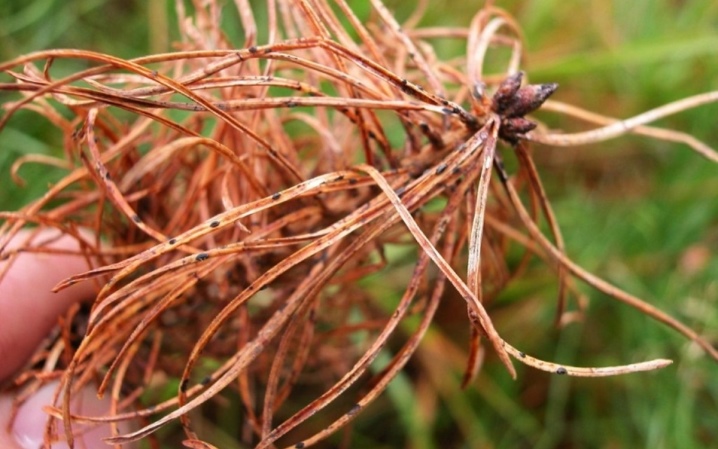
Fusarium
This is a viral infection that affects the root system, as a result of which the tree lacks nutrients, and as a result, the spruce dries up. First, the needles become reddish, dry and fall off. Then the branches begin to die off, the crown becomes rare. The spruce gradually dies.
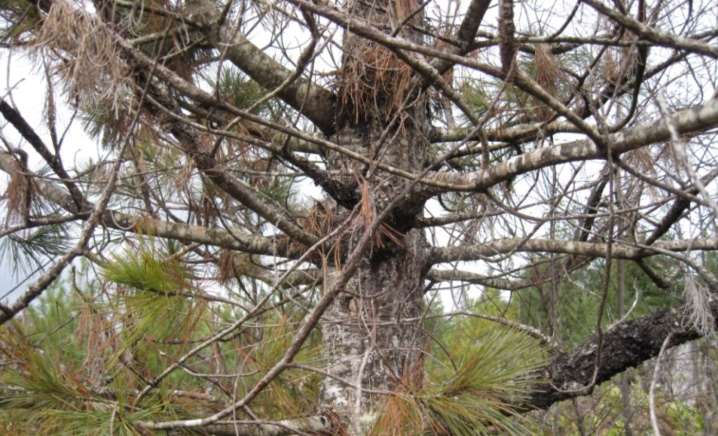
Rust
This disease can affect various parts of the spruce. The cause of the disease is also a fungal infection. The needles of the plant turn yellow, diseased branches change shape and dry out. It is presented in different types.
- Needle rust. The disease begins in early spring. Typical cylindrical yellow blisters appear on the needles, which contain the spores of the fungus. After they mature, the bubbles burst and the spores are carried by the wind, infecting other spruces. Over time, all needles turn yellow and crumble.
- Columnar rust. Starting with the needles, the infection gradually spreads to the bark. It first becomes thicker and then bursts. Yellow bubbles appear in the formed cracks. Sore spots dry out and die off.
- Cones rust. The infection focuses on the inner surface of the scales, where dark pustules form. As the disease progresses, the buds open ahead of time, which leads to the death of the seeds.
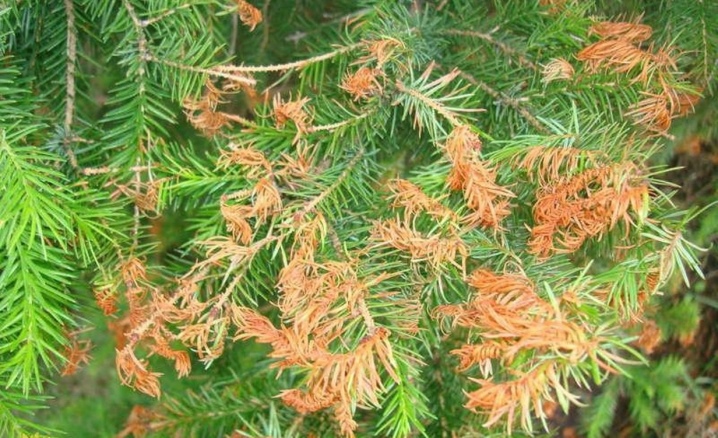
Lichens
This plant symbiotrophic organism has a large number of species and is widespread. One tree can simultaneously become infected with dozens of different types of lichens. They are especially noticeable after rain at high humidity. Lichens have no roots, so they absorb moisture and nutrients from dust and rain across their entire surface. Life expectancy is very long - up to hundreds of years. Lichens like to settle on mature or weakened spruce trees. The main harm they bring is as follows:
- harmful insects and infections can settle under them;
- the full respiration of the tree is disrupted, leading to a slowdown in the process of renewal and growth of the spruce bark, which can cause various other diseases.
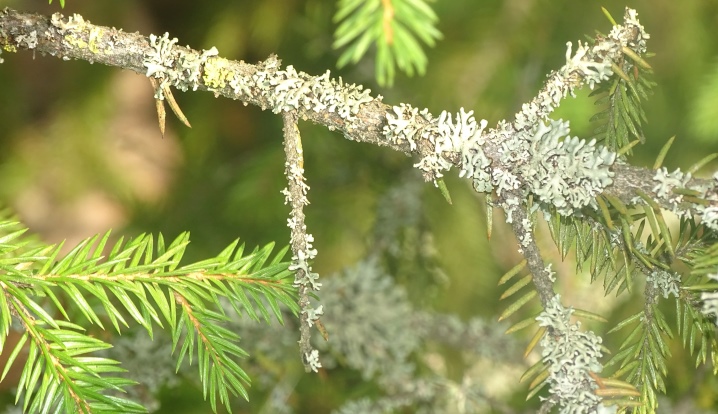
Root sponge
This is another common spruce disease. Its causative agent belongs to the class of basidiomycetes. The danger of this infection is that it attacks the root system and causes it to rot. Fir trees are infected mainly through wounds, cracks and other root injuries. Outwardly, the disease does not manifest itself for a long time, but ate they slow down growth, the needles become short, and resin swells are formed.
Then the fruiting bodies of the fungus appear, which are perennial plant organisms and have different shapes and sizes. They are located in the voids between the roots, in their lower sections or at the root neck. The outer surface of the fungus has a brown or brown tint and concentric wrinkles. The inner white or light yellow fabric resembles a soft cork. The lower part of the fungus consists of tubules, where its spores form.
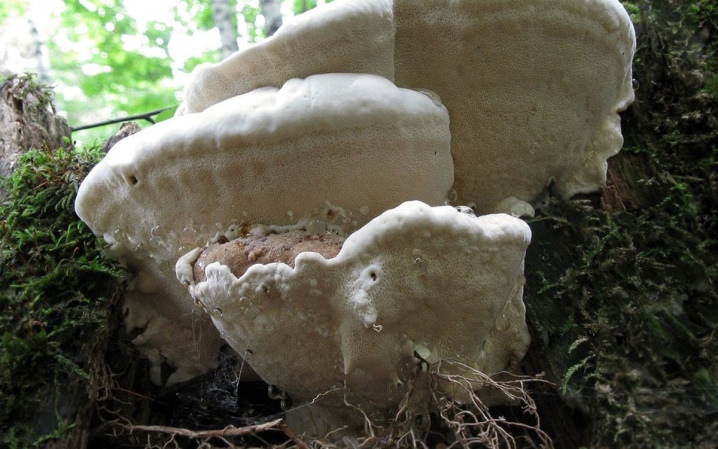
From the roots, the rot gradually passes to the trunk, rising higher and higher, the wood becomes purple, and then reddish-brown. Later, white spots with black lines are formed, which gives the wood a variegated appearance. At the last stage of decay, empty cells appear instead of stains, the wood becomes fragile, soft and threadlike, the smell of mushrooms appears.

You will learn more about the diseases of spruce by watching the following video.
Treatment methods
If symptoms of disease or pest damage are detected, you should immediately begin to combat them. There are different methods of treating diseases.
- Fighting shute consists in systematic spraying of spruce with fungicidal preparations every 2 weeks. The best effect is provided by means "Falcon" and "Quadris", as well as preparations containing copper and sulfur: Bordeaux liquid (1%), "Abiga-Peak", "Fitosporin".

- Fusarium is very difficult to treat. In the treatment, fungicides or biological products are also used, injections are made into the trunk, and the soil under the tree is disinfected. However, self-treatment often does not bring an effect, the tree dies. It is recommended to consult a professional specialist to clarify treatment methods.
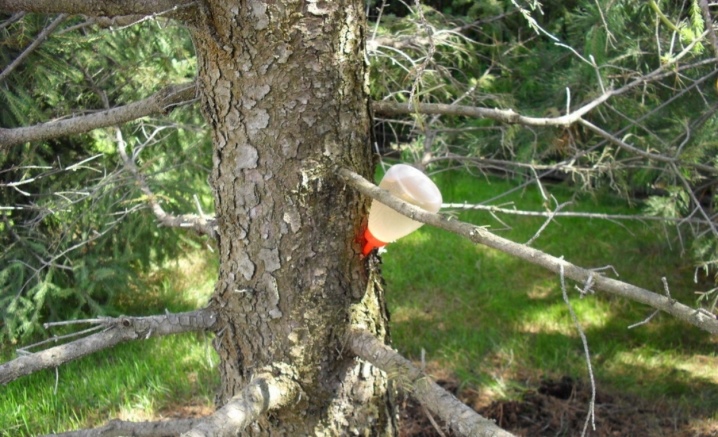
- For rusting spruce, such methods of control are used as:
- mechanical - affected needles and branches are removed;
- chemical - spraying with such means as "Topaz", "Skor", "Strobi", Bordeaux liquid; processing is carried out up to 3 times with an interval of 10 days, and to enhance the effect it is recommended to add the biocidal agent "Kartotsid".
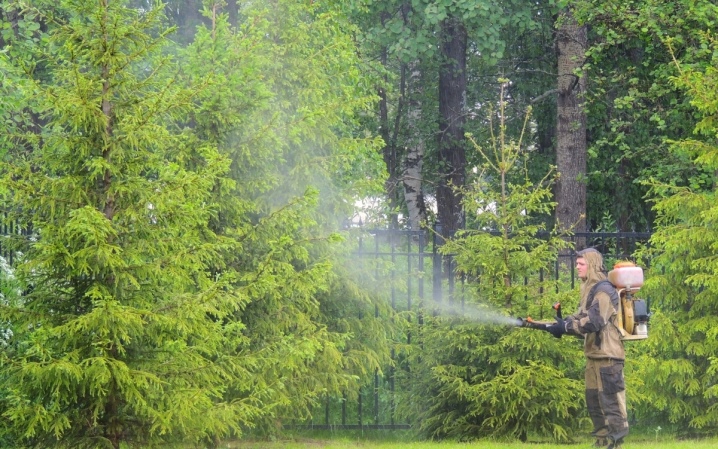
- Fight lichens most efficiently mechanically, scraping them off the trunk and branches with wooden scrapers. After that, these areas need to be treated with a solution of ferrous sulfate (5%) or fungicides.
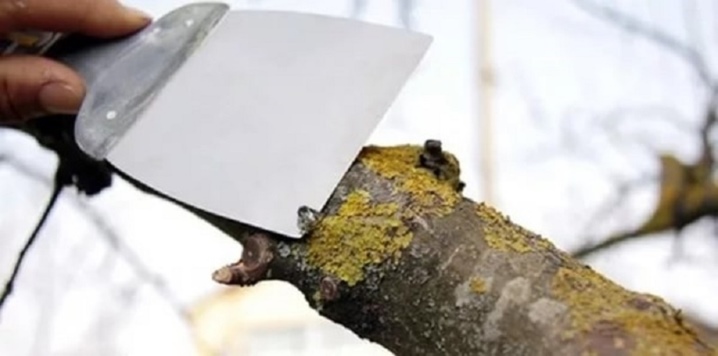
- To prevent the spread of the brown sponge, it is necessary to regularly inspect firs in order to identify the first foci of the disease. The sponge that appears is removed mechanically, and then treated with any fungicides.
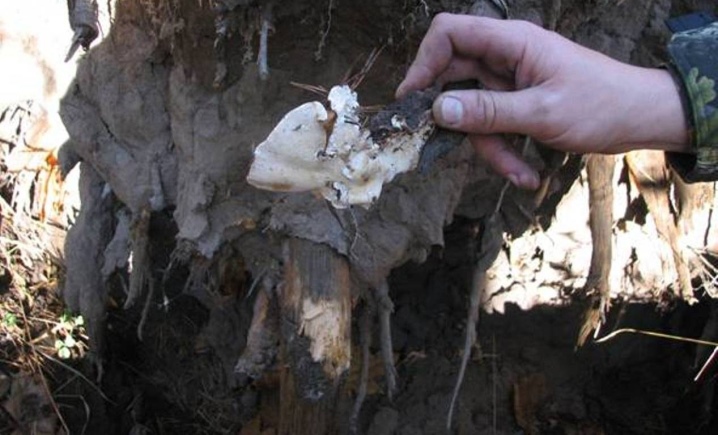
Pests also need to be dealt with in a timely manner.
- With a small lesion of aphids, diseased needles and branches should be removed. A good result is achieved by simply rinsing the aphid colonies off the infested areas with a strong jet of water, or by spraying them with soapy water.Insecticides "Match", "Aktara" are also used. In case of a large infection, it is first necessary to spray with Aktara, and then every 14 days with the Match preparation, alternating with Dursban.

- Spider mites can be fought by spraying with colloidal sulfur, garlic, or dandelion infusion. In case of extensive damage, it is necessary to use drugs-acaricides - "Apollo", "Oberon", "Sunmight".

- In case of minor lesions by a spruce sawer, mechanical methods are used, destroying the nests along with the larvae, followed by spraying with infusions of plants with insecticidal properties (garlic, dandelions). In case of mass destruction, the use of chemical insecticidal agents ("Atellik", "BI-58", "Decis") is required. Likewise, you can get rid of the spruce moth.
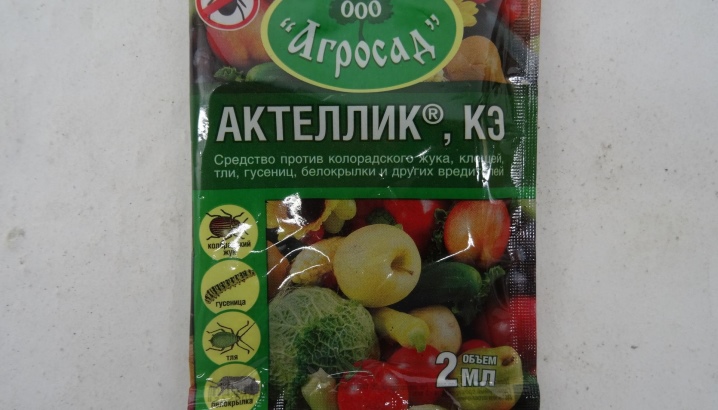
Important! In the fight against bark beetles, the use of such drugs as "Bifentrin", "Sunmight", "Oberon", "Krona-Antip" is effective.
Prophylaxis
It is always more difficult to treat than to prevent disease or pest infestation, so it is important to regularly implement preventive measures.
The main condition for the prevention of all diseases is adherence to agrotechnical rules: correct planting and subsequent care of spruce trees, use only healthy seedlings for breeding.
- annually in early spring, treat the spruce crown with copper-containing agents and insecticidal preparations;
- the ground around the tree should be watered with fungicides and insecticides from pests hibernating in the ground;
- to carry out sanitary pruning of suspicious and dry branches, followed by treatment of the sections with disinfectant solutions and garden varnish;
- regularly remove and destroy fallen needles and dry branches;
- timely feed the spruce with mineral complex fertilizers and preparations that increase the tree's immunity;
- moderately but in a timely manner to water;
- regularly inspect spruce trees for early detection of diseases and pests;
- carry out a timely fight against red ants - carriers of aphids;
- do not allow spruce trees to be adjacent to such plants as poplar, bird cherry, aspen, black currant, which have a predisposition to common diseases and pests.
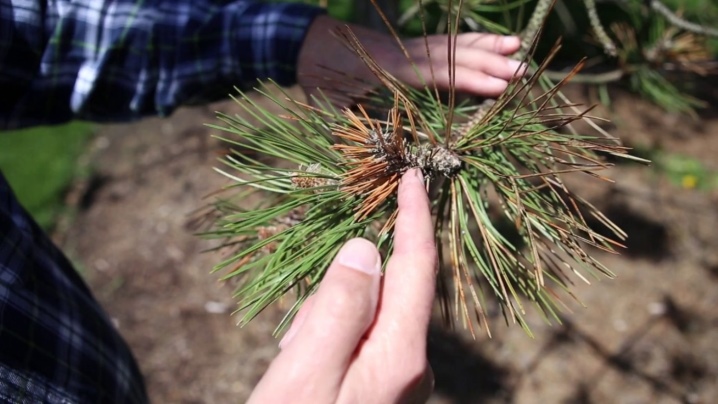



































































The comment was sent successfully.